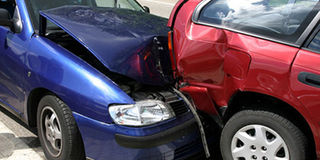Understanding braking and stopping distance

A driver should anticipate every obstacle and drive within the set speed limits to avoid causing accidents. NET photo
What you need to know:
Speed has been cited in most road crashes. Driving is unpredictable and if something unexpected happens on the road ahead, such as a child running into the road, it is a driver’s speed that will determine whether they can stop in time.
One of the safety features that attracted Charles Ofwono to a Mercedes Benz Kompressor is its ability to brake and come to a complete stop even when he is driving fast. Not only does it take a very short time to brake when he steps on the accelerator but does not also skid off the road on sudden braking.
“Much as my car has a strong brake system and stability, I drive at a speed I am able to control and stop the car. I do not compromise my safety by relying on car safety features,” Ofwono says.
Charles Ssebambulidde, the spokesperson of the traffic directorate defines safe braking speed as one where you are driving below 60km/h. He emphasises that any speed above 60km/h is considered not safe for braking, since above this speed, you need a lot of time and strong sense of judgement to stop your car.
It is also important to understand that your safe braking distance and speed are also dependent on the road. For example, along expressways or motorways that are considered to be high speed roads, your safe braking distance and speed ceases to be 60km/hour.
What affects safe braking distance?
Among the factors that affect safe braking distance is weather. If it is raining, braking is at times challenging since the road is slippery. On marrum roads, braking must be done very cautiously.
Infrastructure difference
Ssebambulidde is, however, concerned that public infrastructure such as roads have to be in tandem with superstructure. For example, he says, the current road designs are those of the 1950’s and 60’s at a time when the speedometer of the then manufactured cars went up to 90km/hour, with a few going up to 100km/hour.
“Times have changed and the speedometers being manufactured today are as high as 260km/h and beyond. These are high speed vehicles but the road designs are still old,” Ssebambulidde notes, observing that it is only Entebbe expressway that matches the modern vehicle’s high speeds because it is protected and secured from use by pedestrians and animals.
Type of car
Ismail Kigongo, a motorist, says your safe braking distance is primarily determined by the type of car you drive.
“Some vehicles with old technology tend to be heavy in weight and have a safer braking distance compared to the latest models which are light weight. The lighter the vehicle, the more difficult it is to brake safely and vice versa,” Kigongo explains.
Stopping distance
Kenneth Sunday Kasenene, a road safety officer at the Ministry of Works and Transport, says stopping distance is the distance it takes you to bring your car to a complete stop. However, stopping distance is mainly determined by two factors; thinking and braking distances. In thinking distance, the distance your car will move right from the onset of your eyes coming into contact with an object on the road before your foot steps on the brake pedal. On the other hand, the braking distance is the distance your car takes to brake the moment you step on your brake pedal. It is normally measured in seconds. However, this varies from vehicle to another. “If you double your driving speed, your stopping distance increases by three times. On wet or marrum roads that are not sealed, it may take twice as long to bring your vehicle to a stop,” Kasenene warns.
Place
According to the Uganda Highway code, you must not drive at a speed which might be dangerous to others. Keep checking your speed. For example, slow down if you are approaching a bend, narrow bridge or junction, or a built up area with lots of pedestrians who might cross the road. When driving manual cars, the code advises that you select a gear that will give you most control and smooth movement. Drive slowly if the road is wet or if fog or smoke make it difficult to see or at night when it is harder to see pedestrians, cyclists and animals.
Driving on unsealed roads
Always drive slowly on marrum or unsealed roads, steer gently and avoid hard braking. This is because unsealed or marrum roads are slippery and this increases the risk of losing control and overturning your vehicle.
Right speed
The Uganda Highway code states that if you are driving at 100km/hour, it will take you 73 metres or an 18 car length distance to stop your car from the onset of seeing a pedestrian or any other object.
And if you are driving at 80km/h, it will take you 53 metres or a 13 car length distance to bring your car to a complete stop.




